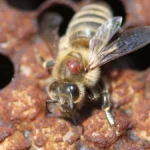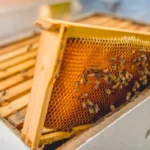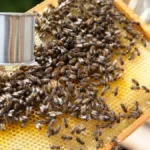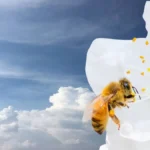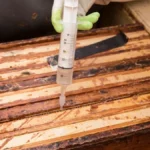What are k wing bees? There is quite a bit of confusion around this term. In this article, we will clear that up. In so doing we will also take a look at a few bee viruses, and how these can be managed.
What Are K-wing Bees?
K-wing bees are precisely that – let’s explain. Normally a bee can clip its wings together when it flies. When it rests or walks around the fore wings can unclip from the hind wings and these would normally stay close together.
When a bee has so-called K-wings, the rear wings will spring backwards making a K shape if you look at the bee from the top. Because the bee cannot clip its wings together, it is unable to fly. The result is we see a lot of bees walking around on the ground and hopping about looking confused.
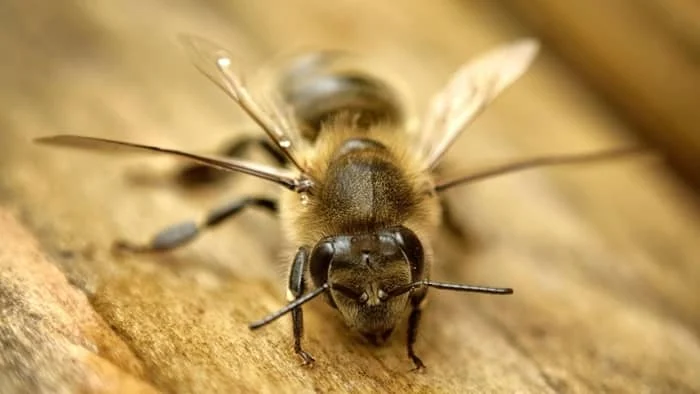
Causes Of K-Wings In Honey Bees
K-wings in bees are a bit like a limp in a person – they are a symptom, not a disease. To find out the root cause we have to delve deeper into the various diseases bees can suffer from. To start this diagnosis, we would normally begin with a microscopic analysis of an affected bee.
Tracheal mites
Tracheal mites – Acarapis woodi – clog up the inside of the bees Trachea. For more on how bees breathe visit this article. These mites also transmit a whole host of viruses and weaken the bees. We will take a quick look at how to get rid of the mites just now.
Age
Old bees can just wear out, and develop K-wings. This is part of the normal cycle. I remember once watching a bee in an observation hive. You could tell she was old. Her thorax was polished bald, and she was offloading a load of pollen. Then she just went and sat quietly in a corner. A few minutes passed (I was being paid to watch bees and record wax scale production). Suddenly her wings popped into the K-formation, she shivered and fell to the bottom of the hive. She had suffered the equivalent of a bee heart attack.
Hence if you see the occasional old (polished thorax) bee with K-wings, do not stress. If, however you see many young fluffy thoraxed bees with K-wings, it is worth being worried.
Viruses
We mentioned earlier that Tracheal mites can transmit viruses. Other mites such as Varroa mites also transmit viruses. There are many bee viruses, and in most cases, these viruses cause little harm. When a vector, such as a mite spreads the virus from one bee to another, the problems develop.
I read a blog recently where someone attributed K-Wings to the Kakugo virus. This is, as far as I can tell, factually incorrect – the Kakugo virus makes bees aggressive. However, the Kakugo virus has some genetic similarities to Deformed Wing Virus.
Deformed Honey Bee Wing Virus
This is an RNA virus. To put this virus into a modern context, it contains about a third of the genetic information that is in COVID-19.
The virus is transmitted mainly by the Varroa mite, which infects larval bees. The virus causes deformities, such as stubby useless wings and deformed legs.
Bees with these deformities typically try to leave the hive and just run along the ground outside the hive until they are captured by ants or other insects. This then attracts ants to the hives and causes additional problems.
How To Limit K-Wings and Deformed Wing Virus Problems
As you have seen in the above descriptions of various symptoms, mites are often at the core of the problem. Hence it is important to control mite levels in your beehive.
Tracheal Mite Control
“Crisco” Patties
My favourite method is the old tried and tested “Crisco patty”. Ideally, you want some sort of vegetable shortening that will go rancid. Mix it with a little more granular white sugar and place a pattie about the same size as a standard burger patty on a sheet of wax.
As tracheal mites age, the fats on their cuticle (skin) go rancid. An old female mite will have a slightly rancid smell. Male mites will find her less attractive and wait for a less rancid younger female to appear. However, if we cover the bees and the mites in rancid vegetable fat, the male mites just don’t find any of the female mites attractive. The mites then don’t breed, and we implement a strict “no child” policy in the hive. The mites die out.
Menthol
You can use menthol to control tracheal mites in a hive. A two-ounce packet of menthol pellets is opened and placed on the top frames of a hive if ambient temperatures are below 60°F. If temperatures are above this, place the packet on the bottom board of the hive.
Menthol vapour permeates the hive and “fumigates” the tracheal mites in the bees. It is important to run such treatments for about two or so weeks to properly get rid of the mites.
Honey Bee Varroa Mite Treatment
It is clear that Deformed Wing Virus is transmitted by varroa mites. Hence deformed wing virus treatment is really just varroa treatment. This is a nice overview of varroa mite control methods.

A Note On Beehive Viruses, Mites and Immunity
I was in South Africa in an area with Apis mellifera capensis bees at the time that the varroa mite arrived. A decade before that the tracheal mite had arrived as well. The bees followed a similar trajectory with both diseases. These indigenous, and largely non-bred (ie you cannot order queens in the post) bees have incredible genetic diversity. When varroa arrived, we saw all the normal symptoms everybody else saw in the rest of the world.
However, the bees did not all die – some survived. For two years, you would see a lot of deformed wing viruses, K-wings, chalkbrood, nosema and various other illnesses. After the third year of varroa being around, these diseases all just faded away. If you go to the Eastern Cape of South Africa and scratch around in those hives now you will struggle to find a varroa mite. You will be amazed what a certain amount of neglect can do to animals. Survival of the fittest is such a powerful tool.
We hope this article has helped you understand K-Wing bees, deformed wing virus bees and how to manage your bees to health. Share if you care. Thanks!
Learn more about: How To Get Rid Of Wax Moths In Beehives
FAQ Section for “What Are K Wing Bees?”
What are K-wing bees?
K-wing bees are bees whose wings are misaligned, forming a distinctive “K” shape. This occurs when the rear wings spring backward, preventing the bee from flying.
What causes K-wings in bees?
K-wings can be caused by several factors, including tracheal mites, old age, and viral infections like Deformed Wing Virus (DWV). It’s a symptom, not a disease.
Are K-wings in bees a sign of a serious problem?
Yes, when K-wings appear in young bees, it may indicate a larger health issue such as a mite infestation or a viral infection. Immediate action may be needed.
How do tracheal mites contribute to K-wing symptoms?
Tracheal mites clog the bees’ airways and weaken them, often leading to K-wings as a symptom. These mites can also spread viruses among bees.
Can Deformed Wing Virus (DWV) cause K-wings?
Yes, DWV, spread primarily by varroa mites, can cause K-wings along with other deformities like stubby wings or deformed legs in bees.
How can I treat tracheal mites in my hive?
Treatments for tracheal mites include Crisco patties or menthol vapors. These methods disrupt mite reproduction, helping to control infestations.
How do Crisco patties work against tracheal mites?
Crisco patties create a rancid environment that confuses male tracheal mites, preventing them from mating with females, effectively reducing the mite population.
What is the best way to manage varroa mites to prevent DWV?
Effective varroa mite control is essential for preventing DWV. This can include chemical treatments, screened bottom boards, or brood interruption techniques.
Can K-wings appear in old bees?
Yes, K-wings can occur naturally in old bees as their bodies wear out. This is part of the aging process and is usually not a cause for concern.
How can I prevent viruses and mites from affecting my bees?
Regular hive monitoring and mite control methods, such as treatments for both tracheal and varroa mites, can help prevent viral infections and K-wings.

Dr. Garth A. Cambray is a Canadian/South African entrepreneur and beekeeper with 28 years of experience in apiculture and specializes in adding value to honey. His Ph.D. research developed a new advanced continuous fermentation method for making mead that has resulted in a number of companies globally being able to access markets for mead. His company, Makana Meadery, exports honey mead to the USA where it is available to discerning connoisseurs. He has also developed technologies to commercially manufacture organic honey vinegar in Zambia for export globally. He holds a few patents globally in the ethanol industry and believes in technology and knowledge transfer for human development and environmental sustainability. One of his proudest achievements is the fact that the wind farm he started at one of his old apiary sites has essentially made his hometown carbon neutral.

